Manuscript accepted on : 07 March 2018
Published online on: --
Curcumin Reduce Sodium Fluoride-Induced Oxidative Stress in Rat Brain
Nagapuri Kiran Kumar, Mesram Nageshwar and Karnati Pratap Reddy
Department of Zoology, Osmania University, Hyderabad, Telangana, India.
Corresponding Author E-mail: pratapkreddyou@gmail.com
DOI : http://dx.doi.org/10.13005/bbra/2609
ABSTRACT: This study reports the ameliorative role of curcumin against sodium fluoride (NaF) induced oxidative stress in the brain of rats. The rats were divided into control, NaF (20 mg/kg), NaF+Curcumin (20mg/kg) and Curcumin (20mg/kg) groups respectively and treated at everyday interval for 60 consecutive days. Oxidative stress markers in the brain were measured at 60th day. NaF treatment significantly increased LPO content, but decreased the level of GSH and activities of SOD, GPx, and CAT the brain of rats in comparison to the control rats. Oral administration of curcumin to fluoride exposed rats significantly reversed the content of lipid peroxidation, as well as enhanced the level of GSH and SOD, GPx and CAT activities to normal compared to NaF exposed rats. Thus, curcumin showed the potential to prevent sodium fluoride induced oxidative damage in the brain of rats and curcumin may be useful agents against neurodegeneration in the brain.
KEYWORDS: Curcumin; NaF; Neurodegeneration LPO;Oxidative Stress;
Download this article as:| Copy the following to cite this article: Kumar N. K, Nageshwar M, Reddy K. P. Curcumin Reduce Sodium Fluoride-Induced Oxidative Stress in Rat Brain. Biosci Biotech Res Asia 2018;15(1). |
| Copy the following to cite this URL: Kumar N. K, Nageshwar M, Reddy K. P. Curcumin Reduce Sodium Fluoride-Induced Oxidative Stress in Rat Brain. Biosci Biotech Res Asia 2018;15(1). Available from: https://www.biotech-asia.org/?p=29303 |
Introduction
Oxygen is vital for the normal function of eukaryotic animals. Its role in survival is linked to its high redox potential, which makes it an excellent oxidizing agent proficient of accepting electrons easily from reduced substrates. Different tissues have different oxygen demands depending on their metabolic desires. The brain is considered to be most sensitive to oxidative damage due to high level of tissue oxygen consumption. Fluorosis disease is the most common neurodegenerative disease, affecting fluoride exposure area people in the worldwide.1 Fluoride is an essential stress element and have the ability to generate oxidative stress in reactive oxygen species (ROS). Dec et al,2 have demonstrated sodium fluoride induced oxidative damage and allied cognitive impairments in brain of rats. In a study, Wang et al,3 has verified memory impairment and mitochondrial oxidative damage against fluoride induced neurotoxicity in animal. The fluoride in variable concentrations induces free radical toxicity in both animals and in people living in areas of endemic fluorosis.4-5 The excessive intake of fluoride also inhibit the physiological function of various kinds of enzymes, leading to disruption in the metabolism of the organism and overall physiological dysfunction.6 Nabavi et al,7 reported that fluorine accumulation leads to decrease the activity of antioxidative enzymes and the increase of the intensity of lipid peroxidation. The antioxidant system mainly includes antioxidants like SOD, GPx, and GSH, play a key role to scavenge the ROS and also regulate the redox state of cells.8 When oxidative stress occurs the ROS scavengers such as GSH, GPx and SOD action was reduced and lipid peroxidation action was increased.
Curcumin is a flavonoid has a long history of food as a part of the human diet. It is extracted from the powdered dry rhizome of Curcuma longa Linn, a perennial herb commonly cultivated in tropical regions of India and china. Several studies have shown that curcumin is more powerful than vitamin E and C in preventing lipid peroxidation and superoxide dismutase.9-10 Curcumin is a potent inhibitor of oxidative stress and possesses anti-carcinogenic, anti-inflammatory, antioxidant and anti-viral activities.11 In addition to its inherent ability to attenuate the reactivity of oxygen free radical species, curcumin has been shown to enhance the activities of enzymes such as catalase, GSH, GPx and SOD.12 There is also evidence that curcumin administration can protect against kidney and liver injury caused by various factors, including ethanol and carbon tetrachloride.11,13 Antioxidant properties of curcumin by benefit of its potential to reduce oxygen free radicals and inhibit lipid peroxidation have been accepted in animal studies.7 Previously Nabavi et al,14 demonstrated the acute administration of NaF (at the rate of 600ppm for one week) induced oxidative stress which was ameliorated by curcumin in brain of rat. However, in the present study, we have examined the effects of administration of curcumin against sodium fluoride induced oxidative stress with chronic dose (20 ppm for 60 days) in brain of rat for 60 days.
Materials and Methods
Chemicals
Curcumin and sodium fluoride were purchased from the Sigma Aldrich Company. All other chemicals used in the experiment were of analytical grade.
Animals
The albino Wister rats were obtained from National Institute of Nutrition, Hyderabad, India. The rats were maintained under standard laboratory conditions in single rat polypropylene cages, exposed with 12h light/dark cycle at room temperature 24±20C. The laboratory conditions were maintained as per the guidelines given by the CPCSEA at Osmania University, Hyderabad, India. The rats were randomly divided into four groups. These are Group-I Control: rats received only tap water. Group-II NaF: rats received 20ppm sodium fluoride through drinking water. Group-III NaF+Curcumin: rats received 20ppm sodium fluoride through drinking water along with Curcumin (20mg/kg bw) through gavage. Group-IV Curcumin: rats received Curcumin (20mg/kg bw) through gavage. The experimental period was 60 days. The brain was dissected and stored at -20oC for biochemical analysis.
Methods
Biochemical Analysis
Lipid Peroxidation (LPO)
Malondialdehyde is an end-product of lipid peroxidation during oxidative stress and is frequently used as an indicator of lipid peroxidation. The amount of brain MDA was measured using the thiobarbituric acid (TBA) assay according to the method described by Garcia et al.15 The absorbance of the pink coloured trimethine condensation product was measured at 533 nm using a spectrophotometer. The results were expressed as nano mole MDA/gm weight of tissue.
Superoxide Dismutase (SOD)
Superoxide dismutase (SOD) activity in the brain was assayed by monitoring its capability to scavenge superoxide radicals generated by auto-oxidation of pyrogallol in the alkalinemedium as per previously described method.16 The increased absorbance was read at 420 nm using a spectrophotometer. The enzyme activity was expressed as Units/mg protein.
Catalase Activity (CAT)
The activity of catalase was measured according to previously described method by Aebi.17 Wherein the breakdown of H2O2 is measured with little modifications. The optical density was measured at 240 nm. The enzyme activity was expressed as µmoles /min/mg protein.
Glutathione (GSH)
The activity of GSH was determined by the using method of Ellman,18 1.0 ml of supernatant was treated with 0.5 ml of Ellman reagent and 0.3 ml of phosphate buffer (0.2 M, pH 8.0). The absorbance was read at 412 nm. The enzyme activity was expressed as µg/mg protein.
GPX
The activity of GPx was assessed by the method of Rotruck et al.19 At the end of reaction, 1 ml of DTNB reagent was added to 3 ml of supernatant and the color developed was measured at 412 nm. The activity was expressed as U/mg protein.
Statistical Analyses
Data presented as Mean ± S.E.M. Statistical comparisons between groups were performed by the use of one-way analysis of variance (ANOVA). Differences were considered as significant (P<0.05).
Results
Biochemical Findings
The values of the LPO content and SOD, CAT, GSH and GPx activities are shown in figures 1, 2, 3, 4 and 5 respectively. Sodium fluoride exposure significantly increased the brain MDA levels (p<0.05) and also decreased the SOD, CAT, GSH and GPx activities (p<0.05) when compared with control. The treatments of curcumin has shown protective effect via decreasing significantly (p<0.05) the elevated LPO content to the level of normal and also significantly (p<0.05) increased the reduced antioxidant enzyme activities (SOD, CAT, GSH and GPx) when compared with sodium fluoride exposure to that of normal level. The curcumin alone treatment has no significant different values from that of control.
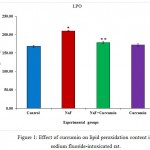 |
Figure 1: Effect of curcumin on lipid peroxidation content in sodium fluoride-intoxicated rat.
|
Values are represented as mean±S.E.M (n=6). *P<0.05 Significant differences respect to control group and **P<0.05 Significant differences respect to NaF treated group.
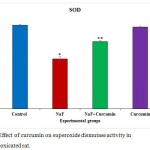 |
Figure 2: Effect of curcumin on superoxide dismutase activity in luoride-intoxicated rat.
|
Values are represented as mean±S.E.M (n=6). *P<0.05 Significant differences respect to control group and **P<0.05 Significant differences respect to NaF treated group.
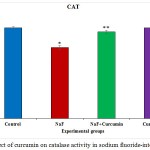 |
Figure 3: Effect of curcumin on catalase activity in sodium fluoride-intoxicated rat.
|
Values are represented as mean±S.E.M (n=6). *P<0.05 Significant differences respect to control group and **P<0.05 Significant differences respect to NaF treated group.
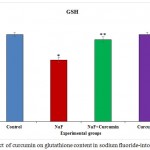 |
Figure 4: Effect of curcumin on glutathione content in sodium fluoride-intoxicated rat.
|
Values are represented as mean±S.E.M (n=6). *P<0.05 Significant differences respect to control group and **P<0.05 Significant differences respect to NaF treated group.
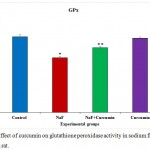 |
Figure 5: Effect of curcumin on glutathione peroxidase activity in sodium fluoride-intoxicated rat.
|
Values are represented as mean±S.E.M (n=6). *P<0.05 Significant differences respect to control group and **P<0.05 Significant differences respect to NaF treated group.
Discussion
The present study, showed the therapeutic potential of curcumin for its neuroprotective action against NaF induced oxidative stress in rat brain. In our studies, the brain damage was produced through administration of NaF in drinking water of rats. The severity of oxidative damage to the brain was estimated by measuring LPO, SOD, CAT, GSH and GPx activities. The results of the study revealed the neuroprotective effect of curcumin against the NaF induced oxidative stress as compared with negative control group (NaF).
Many neurodegenerative diseases involve the accumulation of protein aggregates, oxidative damage, and inflammation. Oxidative stress is one of the popular concepts in neurodegeneration. Oxidative stress is a biochemical process that results in formation of reactive oxygen species in electron transport chain in mitochondria.20 The Oxidative stress disturbs the microvascular epithelium cells leading to form the β-amylod plaque in epithelial cells then form the amyloid precursor protein molecules, can alters cerebro vascular integrity caused to the deprivation of oxygen, toxic metabolites accumulation leads to the neurodegeneration.21 The fluorosis is a one of the neurodegenerative disease resulted with excessive exposure of fluoride in drinking water. Chronic contact to fluoride alters the membrane lipids, reduction of cholinergic receptors in animal studies.22 Sodium fluoride induced oxidative stress is associated to inflicting damage to membrane lipid, proteins and antioxidative enzyme defence system.23 Thus, sodium fluoride might be implicated in the functional decline of mitochondria that may lead to ROS generation.
This study corroborates that the administration of sodium fluoride lead to decrease in antioxidant enzymes such as superoxide dismutase, catalase, glutathione peroxidase and glutathione reductase as well as the reduced glutathione content and increase the LPO levels resulting in the oxidative stress by producing the free radicals.24 Lipid peroxidation denotes one of the most frequent reactions resulting from free radicals attack on biological structures. Earlier studies have recorded increased LPO levels in the liver and kidney of fluorotic rats.7 Zhuo et al,25 reported the decrease in catalase activity through reducing the level of nicotinamide adenine dinucleotide phosphate that is essential to activate the enzyme and also decreased the superoxide dismutase activity in sodium fluoride exposed rats. NaF affects cell antioxidant defense system to induce lipid peroxidation and the disruption of cell membrane polyunsaturated fatty acid.2
Natural antioxidants, such as quercetin, resveratrol, catechin, β-carotene, vitamins C and E have gained tremendous attention, owing to their ability to support the physiological system against many pathological conditions in several diseases.26 Curcumin is also one of the effective polyphenol along with them. Curcumin has multiple desirable characteristics and great potential for the prevention of multiple neurological conditions. In previous antioxidant associated reports demonstrated curcumin declined lipid peroxidation levels in the rodent models and it is played a principal role in cellular redox control.9,27 The beneficial effects of curcumin have been attributed mainly to their antioxidant capacity, including their direct free radical scavenger and their metal chelating activity.28 Curcumin is a good antioxidant and it inhibits lipid peroxidation in liver and kidney homogenates.7,29 Curcumin decreased the lipid peroxidation through maintaining the activities of antioxidant enzymes like superoxide dismutase, catalase and glutathione peroxidase at upper levels. Curcumin also have ability to scavenging oxygen free radicals such as superoxide anions, singlet oxygen, NO and hydroxyl radicals which are important to the initiation of LPO and causing oxidative damage.30 Furthermore, curcumin presents indirect antioxidant effects through its capacity to interact and modulate antioxidant enzyme activities.
The results of the present study are in good agreement with previous reports and confirm that NaF administration increased levels of lipid peroxidation and reduced SOD, CAT activities. Moreover, we found that GSH content and GPx activity in brain reduced after sodium fluoride exposure, indicating an induction of oxidative stress. Our finding is that curcumin treatment significantly reduced elevated lipid peroxidation and improved the decreased SOD, CAT, GSH and GPx enzyme activities in the brain of rats exposed with NaF. The present result is the first evidence of the long term beneficial effect of curcumin on sodium fluoride induced oxidative stress in the brain of rats.
Conclusion
In conclusion, oral administration of curcumin counteracted the sodium fluoride-induced oxidative stress in rats’ brain possibly by reducing the level of lipid peroxidation and improving the activities of superoxide dismutase, catalase, reduced glutathione and GPx enzymatic antioxidants of the brain. The present study suggests that curcumin could be a substantially promising neuro-protective agent against NaF induced oxidative stress. However, additional studies are needed to determine the exact protective mechanism and long-term benefits of curcumin on neuroprotection.
References
- David L.O. Fluoride and environmental health: a review. Environ. Sci. Biotechnol. 2009;8:59-79.
CrossRef - Dec K, Lukomska A, Maciejewska D, Jakubczyk K, Baranowska-Bosiacka I, Chlubek D, Wąsik A, Gutowska I. The Influence of Fluorine on the Disturbances of Homeostasis in the Central Nervous System. Trace. Elem. Res. 2017;177:224-34.
CrossRef - Wang J.D, Ge Y.M, Ning H.M, Wang S.L. Effects of high fluoride and low iodine on biochemical indexes of the brain and learning-memory of offspring rats. 2004;37:201-08.
- Bhardwaj M, Shashi A. Dose effect relationship between high fluoride intake and biomarkers of lipid metabolism in endemic fluorosis. & Prevent. Nutri. 2013;3:121-27.
CrossRef - Hassan H.A, Abdel-Aziz A.F. Evaluation of free radical-scavenging and anti-oxidant properties of blackberry against fluoride toxicity in rats. Chem. Toxicol. 2010;48:1999-004.
CrossRef - Vani L.M, Reddy K.P. Effects of fluoride accumulation on some enzymes of brain and gastrocnemius muscle of mice. 2000;33(1):17-26.
- Nabavi S.F, Moghaddam A.H, Eslami S, Nabavi S.M. Protective effects of curcumin against sodium fluoride-induced toxicity in rat kidneys. Trace. Elem. Res. 2012;145:369-74.
CrossRef - Miltonprabu T. Ameliorative effect of epigallocatechin gallate on sodium fluoride induced oxidative stress mediated metabolism in rat. J. Pharmacol Toxicol. 2014;2(2):76-85.
- Dharmendra K.K, Juvekar A.R. Neuroprotective effect of curcumin as evinced by abrogation of rotenone-induced motor deficits, oxidative and mitochondrial dysfunctions in mouse model of Parkinson’s disease. Biochem and Behav. 2016;150-151:39-47.
CrossRef - Jagatha B, Mythri R.B, Vali S, Bharath M.S. Curcumin treatment alleviates the effects of glutathione depletion in vitro and in vivo: therapeutic implications for Parkinson’s disease explained via in silico studies. Radic. Biol. Med, 2008;44(5):907-17.
CrossRef - Morsy M.A, Abdalla A.M, Mahmoud A.M, Abdelwahab S.A, Mahmoud M.E. Protective effects of curcumin, alpha-lipoic acid, and N-acetylcysteine against carbon tetrachlorideinduced liver fibrosis in rats. Physiol. Biochem. 2012;68(1):29-35.
CrossRef - Mohammad S, AL-Harbi, Reham Z.H, Afaf A. Dwarya Ameliorative effect of selenium and curcumin on sodium fluoride induced hepatotoxicity and oxidative stress in male mice. Chem. Pharm. Res. 2014;6(4):984-98.
- Pooja M, Craig T, Connors A.S, Mohammed S.S, Kathleen M, James A.M, Grady W.C. Turmeric Extract Rescues Ethanol-Induced Developmental Defect in the Zebrafish Model for Fetal Alcohol Spectrum Disorder (FASD). of Food. Scien. 2017;82(9):2221-225.
- Nabavi S.F, Eslami S.H, Moghaddam A.H, Nabavi S.M. Protective Effects of Curcumin against Fluoride-Induced Oxidative Stress in the Rat Brain. 2011;43:287-91.
CrossRef - Garcia Y.J, Rodriguez-Malaver A.J, Penaloza N. Lipid peroxidation measurement by thiobarbituric acid assay in rat cerebellar slices. of Neurosci. Metho. 2005;144(1):127-35.
- Marklund S, Marklund G. Involvement of the superoxide anion radical in the autoxidation of pyrogallol and a convenient assay for superoxide dismutase. J. of Biochem., 1974;47(3):469-74.
CrossRef - Aebi H. Catalase in vitro. in Enzymo. 1984;105:121-26.
- Ellman G.L. Tissue sulphydryl group. of Biochem and Biophys. 1959;82:70-77.
- Rotruck J.T, Pope A.L, Ganther H.E, Swanson A.B, Hafeman D.G, Hoekstra W.G. Selenium: Biochemical role as a component of glutathione peroxidase. 1973;179(4073):588-90.
CrossRef - Mahaboob B.P, Saumya S.M. Suppression of mitochondrial oxidative phosphorylation and TCA enzymes in discrete brain regions of mice exposed to high fluoride: amelioration by Panax ginseng (Ginseng) and Lagerstroemia speciosa (Banaba) extracts. Mol. Neurobiol. 2013;33(3):453-64.
CrossRef - Bhatnagar M, Rao P, Sushma J, Bhatnagar R. Neurotoxicity of fluoride: Neurodegeneration in hippocampus of female mice. J. Exp. Biol. 2002;40:546-54.
- Guo X.Y, Sun G.F, Sun Y.C. Oxidative stress from fluoride-induced hepatotoxicity in rats. 2003 36(1):25-29.
- Mandava V.R, Rajendra N.B. Protective effect of melatonin on fluoride-induced oxidative stress and testicular dysfunction in rats. 2012;45(2):116-24.
- AL-Harbia S.M, Reham Z.H, Afaf A.D. Ameliorative effect of selenium and curcumin on sodium fluoride induced hepatotoxicity and oxidative stress in male mice. Chem. Pharmaceut. Res. 2014;6(4):984-98.
- Zhuo Z, Bo Z, Hiaohong W, Fei W, Yingli S, Shengnan L, Shuhua X. Maize Purple Plant Pigment Protects Against Fluoride-Induced Oxidative Damage of Liver and Kidney in Rats. J. Environ. Res. Public. Health. 2014;11:1020-033.
CrossRef - Bureau G, Longpre F, Martinoli M.G. Resveratrol and quercetin, two natural polyphenols, reduce apoptotic neuronal cell death induced by neuro-inflammation. Neurosci. Res. 2008;86(2):403-10.
CrossRef - Hamid R.M, Najmeh E. Effect of curcumin on kidney histopathological changes, lipid peroxidation and total antioxidant capacity of serum in sodium arsenite-treated mice. Experime and Toxicol. Pathol. 2017;69:93-97.
CrossRef - Nabavi S.F, Moghaddan A.H, Nabavi S.M, Eslami S. Protective effects of curcumin and quercetin on thyroid function in sodium fluoride intoxicated rats. 2011;44(3):147-152.
- Fu Y, Zheng S, Lin J, Ryerse J, Chen A. Curcumin protects the rat liver from CCl4-caused injury and fibrogenesis by attenuating oxidative stress and suppressing inflammation. pharmacol. 2008;73:399-09.
- Noha I.S, Magda M.N, Azza A.S. Modulatory effect of curcumin against genotoxicity and oxidative stress induced by cisplatin and methotrexate in male mice. Food and Chem. Toxicol. 2017;105:370-76.
CrossRef

This work is licensed under a Creative Commons Attribution 4.0 International License.





